Extraordinary tale of scientist parents who adopted a chimpanzee to raise as their baby’s SISTER – but bitterly regretted bizarre ‘nature versus nurture’ experiment on their son after it yielded chilling results
Extraordinary video footage shows how two scientist parents tried to raise their son with a chimpanzee in 1931 as part of a bizarre nature versus nurture experiment.
Psychologists Winthrop and Luella Kellogg conducted the study with their 10-month-old son Donald and a 7-month-old chimpanzee named Gua in their Florida home.
The couple tried to determine whether it was possible to raise a monkey and teach it to communicate like a human.
But the experiment, which they planned to run for five years, was halted after just nine months when the couple noticed chilling changes in their son’s behavior.
In 1931, a scientist couple tried to raise their son with a chimpanzee to test the limits of nature versus nurture.
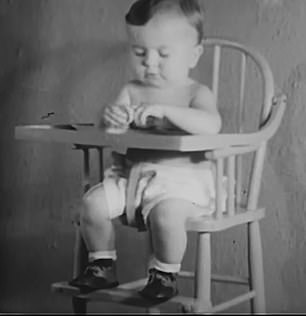
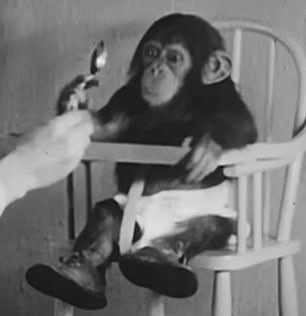
The couple conducted the experiment on their ten-month-old son Donald and a seven-month-old chimpanzee named Gua
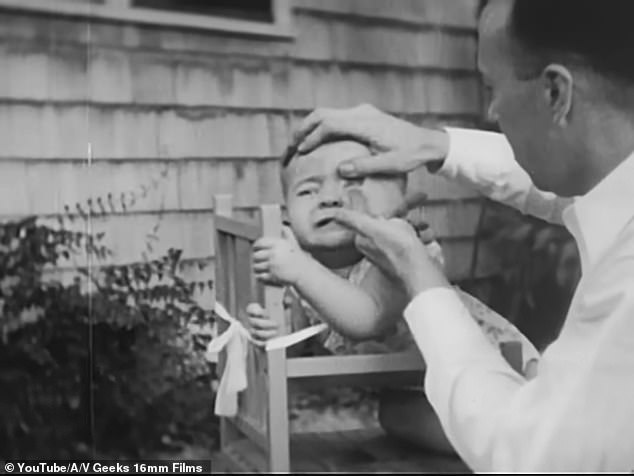
The research was intended to investigate the extent to which a chimpanzee could be socialized, but often involved cruel experiments, including this one pictured – where Donald was teased to the point of distress.
Winthrop devised the experiment after becoming fascinated with the “wolf children” of India – a group of children who adopted the behavior of wild animals after being raised away from civilization.
After determining that raising a child in the wild would be unethical and dangerous, the couple decided to instead bring a monkey into their home and raise it as their son.
Baby Donald and Gua were both woken up at the same time and fed together.
The chimpanzee was dressed like a baby, with sporty onesies or a diaper and even small shoes.
She enjoyed her meals in a high chair, was driven around in a stroller and slept in a bed. And at the end of the day she – just like Donald – received a goodnight kiss.
The couple then tried to teach Gua the same skills as a toddler.
She learned to eat with a spoon, drink from a glass and open doors – long before even Donald had acquired the same skills.
The baby and chimpanzee quickly became incredibly close, developing a brother-sister-like bond from being together all day.
But Donald and Gua were also subjected to a barrage of unusual and often brutal experiments aimed at comparing their reflexes and reactions to scenarios – with their parents recording their findings in detailed notes and on film.
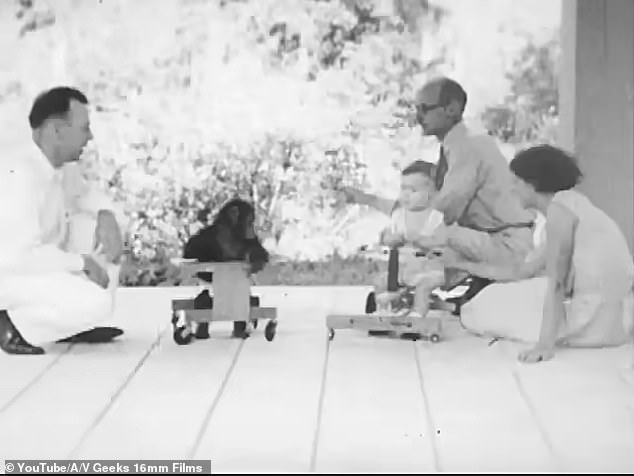
In one particularly disturbing experiment, the couple fired a gun inches from the test subjects to test which would be the first to respond to the sound
Video from one experiment showed a gun being fired just inches away from their heads as the scientists tried to figure out which weapon would respond first to a loud noise.
When the weapon was released, the youths both recoiled before Gua dramatically scrambled into the arms of one of the scientists for safety.
In another disturbing experiment, they both spun at high speed. The test only ended when Donald burst into tears.
A similarly cruel test consisted of teasing Donald to the point of distress.
Accounts of the couple also described hitting the two on the head with spoons, ostensibly to try to hear the difference in their skulls.
Other tests appear more benign, including offering both Gua and Donald a spoon while they sit in a high chair to check which hand is dominant.
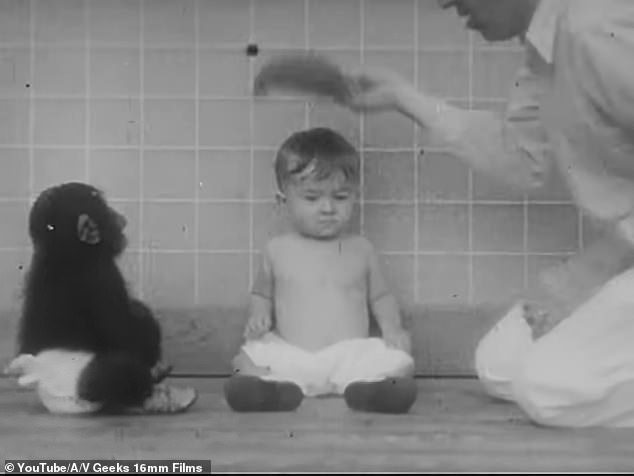
It wasn’t long before Gua began exhibiting human-like behaviors, including eating with a spoon and walking on her two legs
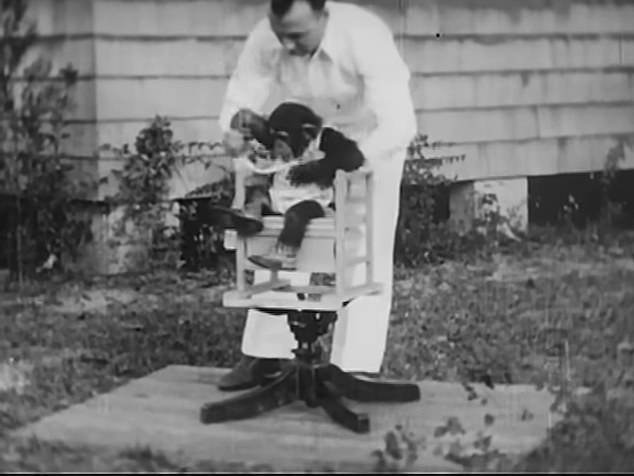
However, Donald also began to adopt monkey-like behavior, including dragging his knuckles, barking, and biting people out of aggression.
In one test, the couple set up obstacles to check how long it would take for the “siblings” to get around them.
Footage shows Luella Kellogg beckoning her young son before hiding behind a screen and waiting for him to figure out how to get around it.
The couple was obsessed with teaching Gua to speak, with Luella often trying to move her lips to form words.
During the experiment, the two were also checked for blood pressure, memory, body size, scratching, reflexes, depth perception, vocalization, locomotion, responses to tickling, strength, manual dexterity, problem solving, fears, balance, play behavior, climbing, etc. obedience, grasping, language comprehension , attention span and more,” according to a note from psychologists.
Initially, Gua’s development was much faster than Donald’s, especially when it came to motor skills.
She learned to respond to 95 sentences, including “show me your nose” and “kiss Donald.”
But eventually she began to stagnate and was overtaken by Donald, especially when it came to speech.
Despite the couple’s best efforts, Gua could never utter a single word and communicated only with grunts.
And it didn’t take long for the couple to realize that by socializing Gua to become human, their son had taken on some animal traits.
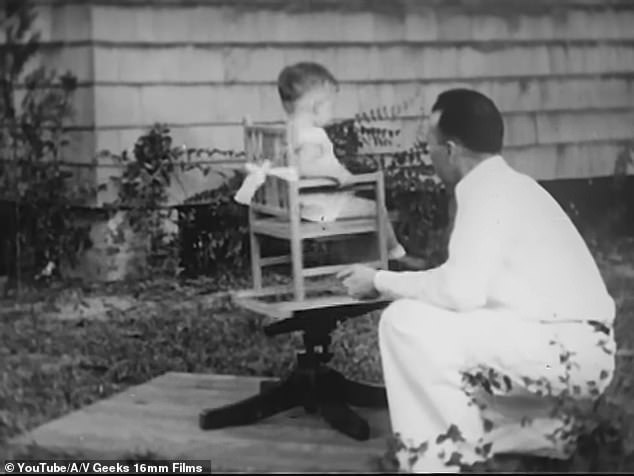
Part of the research involved the couple trying unsuccessfully to teach the chimpanzee to talk
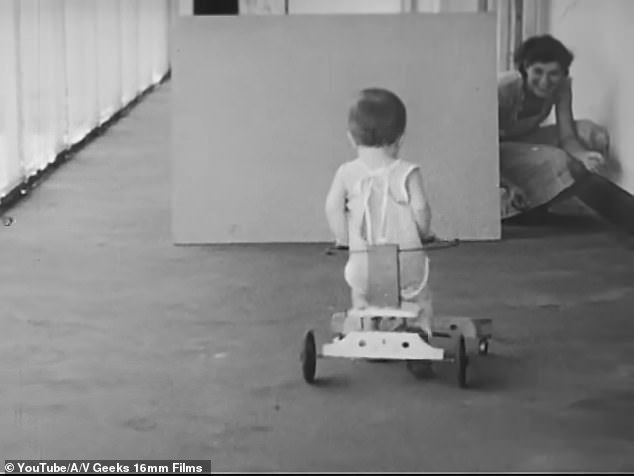
The study was eventually stopped after just nine months when the scientists became concerned about their son’s behavior
Donald started walking around on his hands and knees, dragging his knuckles like a monkey.
He often started biting people when he became aggressive and he and Gua shared a secret language of bark-like sounds that they used to communicate.
Donald began to lag behind his peers developmentally, often choosing to avoid other children in favor of playing with Gua.
Meanwhile, Gua became stronger and more unpredictable.
Ultimately, the couple became so concerned about Donald’s behavior and the possibility of Gua lashing out that they chose to end the experiment early.
They also reportedly lost interest in the experiment after failing to teach Gua to speak.
Gua was returned to captivity and became the subject of another experiment. She spent the rest of her life in a laboratory cage.
“In a very short time, Gua’s life had changed from a child raised in a human home, complete with a two-parent household, a sibling, a house, clothes, and a bed, to a caged laboratory primate,” writes by Andrew R. Halloran in his 2021 book The Monkey’s Song: Understanding chimpanzee languages.
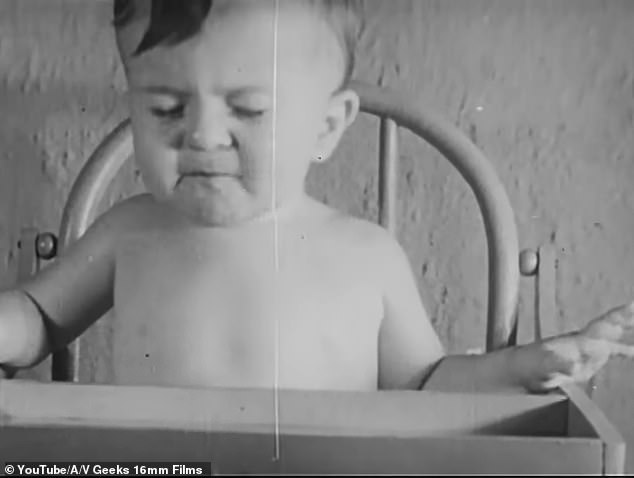
Donald finally took his own life in 1973 at the age of 43. Gua was returned to a laboratory and spent her final years in a cage before contracting pneumonia, which killed her.
Two years later, Gua contracted pneumonia and died. The results of the Kelloggs’ research were published in 1933, entitled The monkey and the child.
The study concluded that “there are clear limits to the degree of humanization that can be achieved by non-human species, regardless of the amount of socializing and humanizing effects.”
Little is known about the impact of the experiment on Donald, but he tragically took his own life in January 1973 at the age of 43.
His suicide came after the deaths of both parents in the summer of 1972.
